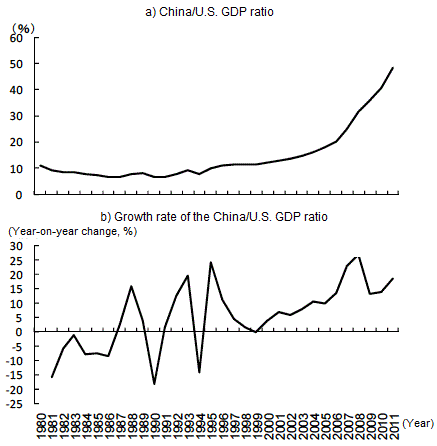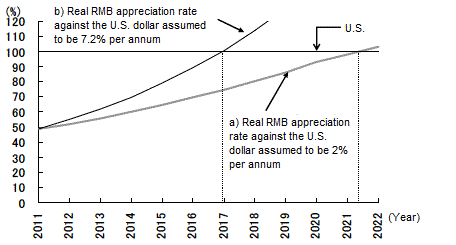Against the backdrop of high economic growth and the renminbi's (RMB) appreciation against the U.S. dollar, China's dollar-based gross domestic product (GDP) has been increasing rapidly in recent years, and there is a growing likelihood for China to overtake the United States as the world's largest economy before 2020.
Rapidly shrinking U.S.-China GDP gap amid RMB appreciation
Back in 1980 when the reform and opening-up policy was still in its initial phase, China's GDP stood at $303.4 billion, a size equal to a mere 10.9% of that of the United States. The ratio of China's dollar-based GDP to that of the United States (China/U.S. GDP ratio) rose to 48.4% in 2011, showing a significant reduction in the GDP gap between the two countries (Figure 1). However, the pace of catch-up has varied greatly across time. After declining between 1980 and 1986, the China/U.S. GDP ratio turned upward, but it was only in 1996 that the ratio returned to the 1980 level. The pace of rise in the China/U.S. GDP ratio accelerated after the turn of the century, particularly after China shifted to the managed floating exchange rate regime in 2005.
Figure 1: Shrinking U.S.-China GDP gap |
 |
| Note: China's GDP is measured in U.S. dollar terms. |
| Source: Compiled by the author based on official statistics of the United States and China. |
In order to examine the causes of such variations, we decomposed the growth rate of the China/U.S. GDP ratio into the following three components: 1) difference in the real GDP growth rate (economic growth rate) between the two countries, 2) difference in the GDP deflator growth rate between the two countries, and 3) nominal appreciation rate of the RMB against the U.S. dollar (Table 1). The sum of 2) and 3) equals the real appreciation rate of the RMB against the U.S. dollar. Our analysis has found that the U.S.-China gap in the real GDP growth rate has been relatively stable over the years, and changes in the growth rate of the China/U.S. GDP ratio are primarily attributable to changes in the real appreciation rate of the RMB against the U.S. dollar, particularly those in the nominal appreciation rate of the RMB against the U.S. dollar. Specifically, in the period through 1995, the decline in the RMB's real exchange rate against the U.S. dollar dragged down the growth rate of the China/U.S. GDP ratio. Conversely, since 2006, the rise in the RMB's real exchange rate against the U.S. dollar (7.2% per annum) has pushed up the growth rate of the China/U.S. GDP ratio to a very high level, 16.6% per annum.
Table 1: Decomposition of the growth rate of the China/U.S. GDP ratio |
 |
| Note: The growth rate of each factor is computed as an increment in its natural logarithm. The figures represent the contribution to the growth rate of the China/U.S. GDP ratio. |
| Source: Compiled by the author based on official statistics of the United States and China. |
Structural changes in the Chinese economy spurring a rise in the real RMB exchange rates
The upturn of the real RMB exchange rate against the U.S. dollar after the downward trend that continued over a prolonged period of time primarily reflects the following structural changes in China.
First, China is shifting rapidly from a stage of labor surplus to that of labor shortage. As a general rule, in a country with high growth, improved productivity in the tradable goods sector (industrial sector) drives up wages not only in the tradable goods sector but also in non-tradable goods sector (service sector). Whereas a rise in wages in the tradable goods sector, which is matched with the pace of productivity improvement, does not lead to a rise in industrial product prices, that in the non-tradable goods sector, which exceeds the pace of productivity improvement, causes an increase in service prices, eventually leading to higher general prices and real exchange rate appreciation (Balassa-Samuelson Hypothesis). In China, the rise in wages relative to productivity improvement in the tradable goods sector had remained modest for many years due to the presence of a surplus rural labor force. However, as the stock of rural labor force has depleted significantly in recent years, high growth in the Chinese economy has started driving up the real exchange rate of the RMB against the U.S. dollar by way of wage increases.
Likewise, due to a lack of international competitiveness, an increase in exports (supply) had long been a factor causing deterioration in the terms of trade for China and hence a downward force on the real exchange rate of the RMB against the U.S. dollar. However, as China's exports have become more competitive in recent years, an increase in demand for made-in-China products has started exerting upward pressure on the real exchange rate of the RMB against the U.S. dollar by way of higher export prices and improvement in the terms of trade.
RMB appreciation to accelerate the U.S.-China reversal in GDP ranking
In my book China as No. 1 published by Toyo Keizai, Inc. in 2009, I forecasted China to overtake the United States in GDP size in 2026, a conclusion drawn from a projection based on the actual figures for 2008 (China/U.S. GDP ratio of 31.6%), assuming that the Chinese economy will grow much faster than the U.S. economy (at an annual rate of 8% till 2020 and 6% from 2021 to 2030 compared to an annual rate of 2.5% for the United States throughout the years) and that the real exchange rate of the RMB against the U.S. dollar will appreciate at an annual rate of 2%. However, the pace of China's dollar-based GDP growth in the period 2009 to 2011 turned out to be far greater than had been expected at the time of writing of the book, and it is now expected that the real exchange rate will likely appreciate at a pace greater than 2% per annum going forward. Based on these new facts and prospects, I would like to revise my projection of the timing of China's GDP exceeding that of the United States.
To begin with, China's high growth of about 10% that has been maintained over the past 30 years will become unsustainable due to a decrease in the working-age population and a depletion of labor surplus in the rural areas. However, judging from a series of economic indicators including the average life expectancy, infant mortality, share of primary industry to GDP, Engel's coefficient, and power consumption per capita, China still lags behind advanced economies by about 40 years. This means that China can introduce overseas advanced technologies easily, and significant room remains to improve productivity through the upgrading of industries. By taking advantage of such backwardness, China will be able to maintain higher economic growth than the United States for some time. In consideration of this, I believe that the assumption used in the previous projection remains reasonable insofar as the two countries' future economic growth is concerned.
Using the China/U.S. GDP ratio in 2011 (48.4%) as our starting point, under the same assumptions for both RMB appreciation (2% against the U.S. dollar in real terms) and the same economic growth as before, China's GDP is projected to surpass that of the United States in 2022 (Figure 2). In reality, however, the real RMB exchange rate against the U.S. dollar has been rising at 7.2% per annum since 2006. Assuming that the pace of RMB appreciation will be maintained going forward, the U.S.-China reversal in GDP ranking could occur as early as 2017. In any event, it will not be so long before we see China surpassing the United States as the No. 1 economy in the world.
Figure 2: Timing at which China will overtake the United States in GDP —Projection of the China/U.S. GDP ratio— |
 |
| Note: Estimates under the assumption of China's economic growth rate of 8% through 2020 and 6% from 2021 to 2030 and the U.S. economic growth rate of 2.5%. |
| Source: Data for 2011 have been developed by the author based on official statistics of the United States and China. |


